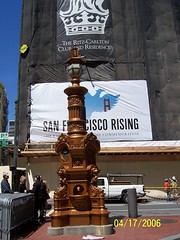We pointed the car west to Half Moon Bay. The first stop was
Barbara's Fish Trap, a very popular seafood house in
Princeton-by-the-Sea. Barbara's Fish Trap has the no-frills ambience of the fishmonger's restaurant. It doesn't accept credit cards, the fish is very fresh, and there's a wait for a table even at 2 p.m. on a weekday. The fellow in front of us said that he always comes to Barbara's when he visits from Riverside, 434 miles to the south.
 |
| Yes, the price of the saddle is $3,000. |
We ordered the fish- or calamari-and-chips, and the food tasted as good as it looked. The hot, crunchy crust married with a moist, tender interior rivaled the best Japanese tempura. We shared an appetizer of clam chowder in a bread bowl. Dipping chunks of sourdough into a thick mixture of clams, spices, and celery (but no cream, the chowder is ideal for the lactose intolerant) is the quintessential experience on the Northern California coast. Four fish entrees, clam chowder, three soft drinks, tax, and a 16% tip cost an even $100.

Our next stop was the
Half Moon Bay Feed and Fuel store on Main Street. Live chickens were on display in coops close to the sign "The Best Place to Pick Up Chicks."
On the front door was a Romney-Ryan sticker. Inside, scattered among the feed and livestock paraphernalia, were politically incorrect signs and cards. A moosehead was mounted over the front door. The sensibility of the store in these parts is, to say the least, unique.
Prices, except for a few outliers like a $3,000 "show saddle," compared very favorably to those in the closer-in suburbs. We picked up some supplies for our guinea pigs. A large bag of grass was $5, a fraction of the cost online or at PetSmart. When we complained to the owner that alfalfa was mixed in with the grass (calcium in alfalfa can cause bladder stones in small animals), she promptly instructed the workers to fill a new bag from the pristine bales outside.
 |
| Half Moon Bay Feed and Fuel is on historic Main Street. |
Our final stop was the
New Leaf Community Market, an organic-food chain that is slowly expanding into the Bay Area, though it's unlikely that we'll have one on the Peninsula any time soon. The prices were equal to or less (in some cases much less) than Whole Foods, so we bought three shopping bags (recyclable, of course) full of groceries.
I was in Half Moon Bay just over a year ago for a charity function. We won't wait as long for our next visit.
© 2013 Stephen Yuen






















